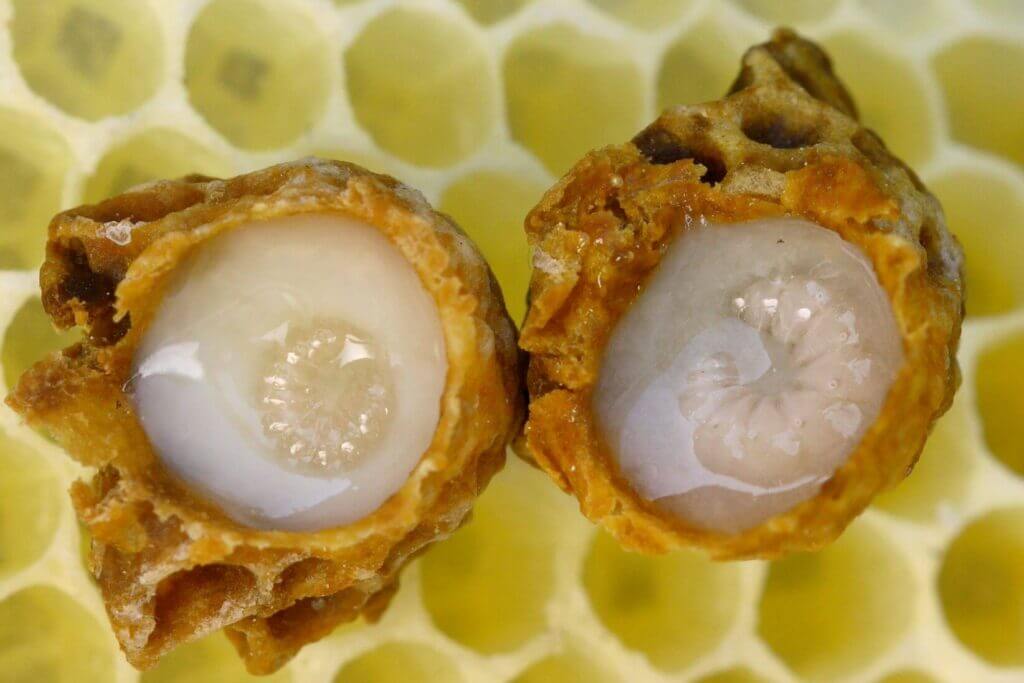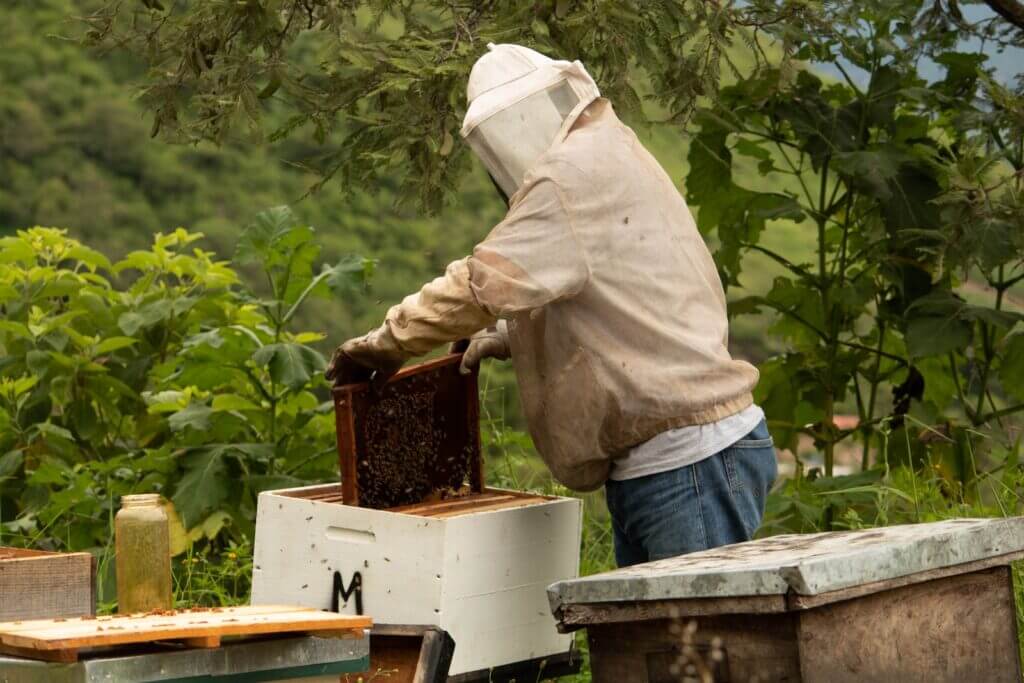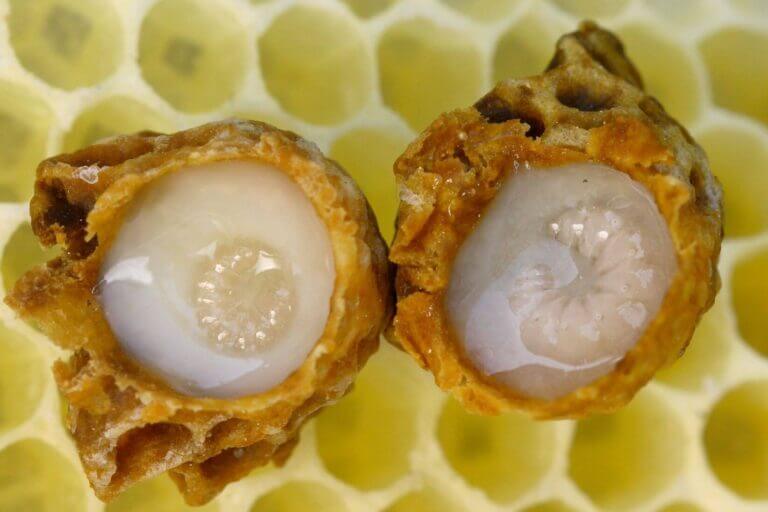Learn the step-by-step process of making royal jelly, including collecting, separating, filtering, and packaging. Explore the factors influencing production and the tools and equipment used. Discover quality control methods and techniques for harvesting royal jelly.
The Process of Making Royal Jelly
Royal jelly is a highly valuable substance produced by bees, known for its numerous health benefits and nutritional value. In this section, we will explore the intricate process of making royal jelly, from collecting it from bees to packaging and storing it for consumption.

Collecting Royal Jelly from Bees
The first step in the process of making royal jelly is collecting it from bees. Beekeepers carefully handle the beehives to extract this precious substance. They pay close attention to the health and strength of the bee colonies, as it directly affects the quality and quantity of royal jelly produced.
Beekeepers use various methods to collect royal jelly. One common method is to place specially designed frames inside the beehives. These frames have small cups or grooves where the bees deposit the royal jelly. The beekeeper then removes these frames and collects the royal jelly using extraction tools and devices.
Separating Royal Jelly from Honey and Pollen
Once the royal jelly is collected, it needs to be separated from honey and pollen. This is an important step to ensure the purity and quality of the final product. Beekeepers use different techniques to achieve this separation.
One method involves refrigerating the collected royal jelly. The low temperature causes the royal jelly to solidify, making it easier to remove from the honey and pollen. Beekeepers carefully scrape off the solidified royal jelly, leaving behind the honey and pollen.
Another method involves using a fine mesh filter to separate the royal jelly from the honey and pollen. This allows only the royal jelly to pass through, while retaining the larger particles. Beekeepers may also employ centrifugal force to separate the different components, with the royal jelly being denser and settling at the bottom.
Filtering and Purifying Royal Jelly
After separating the royal jelly from honey and pollen, it undergoes a filtering and purifying process. This step ensures that any impurities or contaminants are removed, resulting in a pure and high-quality product.
Beekeepers use filtration systems to remove any remaining solids or foreign particles from the royal jelly. These filtration systems typically consist of multiple layers of fine mesh screens or sieves. The royal jelly is passed through these screens, allowing only the pure liquid to pass through while retaining any unwanted substances.
In addition to filtration, beekeepers may also employ purification techniques such as heat treatment or ultraviolet light exposure. These methods help eliminate any potential bacteria or microorganisms that may be present in the royal jelly.
Packaging and Storing Royal Jelly
Once the royal jelly is filtered and purified, it is ready for packaging and storing. Proper packaging is crucial to maintain the freshness and quality of the royal jelly over an extended period.
Beekeepers use specialized containers made of glass or food-grade plastic to store the royal jelly. These containers are airtight and ensure that the royal jelly remains protected from exposure to air, light, and moisture, which can degrade its quality.
To further enhance the shelf life of royal jelly, it is recommended to store it in a cool and dark place, such as a refrigerator. This helps slow down the natural degradation process and preserves the nutritional value of the royal jelly for longer periods.
Factors Affecting Royal Jelly Production
Bee Colony Strength and Health
Royal jelly production is greatly influenced by the strength and health of the bee colony. A strong and healthy colony will have a larger population of worker bees, resulting in a higher production of royal jelly. It is essential for beekeepers to maintain the well-being of their colonies through regular inspections, disease management, and providing a suitable environment.
To ensure the strength and health of the bee colony, beekeepers should regularly monitor the population and productivity of the hive. This can be done by observing the number of worker bees and brood cells, as well as checking for signs of disease or stress. By maintaining a healthy colony, beekeepers can maximize the production of royal jelly.
Availability of Floral Resources
Floral resources play a crucial role in royal jelly production. Bees collect nectar and pollen from flowers to feed the larvae and produce royal jelly. The availability of diverse and abundant floral resources directly impacts the quantity and quality of royal jelly.
Beekeepers should ensure that there is a sufficient supply of suitable flowers in the vicinity of the beehives. This can be achieved by planting bee-friendly plants and providing a diverse range of flowering plants throughout the year. By ensuring a steady supply of floral resources, beekeepers can support the production of high-quality royal jelly.
Climate and Seasonal Changes
Climate and seasonal changes can significantly affect the production of royal jelly. Bees are highly sensitive to temperature and weather conditions, which can impact their foraging activities and the overall productivity of the hive.
Extreme temperatures, such as excessive heat or cold, can disrupt the foraging behavior of bees and reduce the availability of floral resources. Changes in rainfall patterns and seasonal variations can also affect the flowering and blooming of plants, directly impacting the production of royal jelly.
Beekeepers should monitor weather conditions and make necessary adjustments to protect the bee colonies from extreme temperatures. Providing shade and proper ventilation during hot weather and insulating the hives during cold weather can help maintain optimal conditions for royal jelly production.
Beekeeper Management Practices
Effective beekeeper management practices are essential for maximizing royal jelly production. Beekeepers should have a comprehensive understanding of bee behavior, hive management techniques, and the specific requirements for royal jelly production.
Regular inspections and timely interventions are crucial to maintaining colony health and productivity. Beekeepers should be skilled in identifying signs of disease, parasite infestation, or queen issues that may affect royal jelly production. They should also ensure proper nutrition for the bees by supplementing their diet when necessary.
Furthermore, beekeepers should provide a clean and hygienic environment for the bees. Regularly cleaning the beehives and equipment, as well as practicing good sanitation practices, can prevent the spread of diseases and maintain the overall health of the colony.
Tools and Equipment Used in Royal Jelly Production

Royal jelly production requires a set of specialized tools and equipment to ensure the efficient collection, extraction, storage, and packaging of this valuable substance. From beehives and frames to extraction tools and storage equipment, each component plays a crucial role in the overall process. In this section, we will explore the various tools and equipment used in royal jelly production, including beehives and frames, beekeeper suits and protective gear, extraction tools and devices, and storage and packaging equipment.
Beehives and Frames
Beehives are the foundation of any successful royal jelly production operation. These structures provide a safe and conducive environment for bees to thrive and produce royal jelly. Traditional beehives are typically made of wood and consist of several components, including the bottom board, brood boxes, honey supers, inner covers, and outer covers.
Frames, within the beehives, are essential for the bees to build honeycombs and store royal jelly. These frames are usually made of wood or plastic and are designed with a grid pattern that guides the bees to construct their honeycombs in a uniform manner. The frames can be easily removed for inspection, allowing beekeepers to access the royal jelly without causing significant disruption to the colony.
Beekeeper Suits and Protective Gear
Working with bees requires protective clothing to ensure the safety of the beekeepers. Beekeeper suits, consisting of a full-body coverall, gloves, and a veil, are designed to provide complete protection against bee stings. The suits are typically made of lightweight, breathable fabric that shields the beekeeper from bee stings while allowing them to move freely and comfortably.
In addition to the beekeeper suit, protective gear such as gloves and veils are essential to prevent direct contact with bees. Gloves made of leather or rubber protect the hands from stings, while veils made of fine mesh or clear plastic shield the beekeeper’s face and neck from bee encounters.
Extraction Tools and Devices
The extraction of royal jelly requires the use of specialized tools and devices to ensure its careful removal without harming the bees or compromising the quality of the product. One commonly used tool is the royal jelly spoon, which is a delicate instrument designed to scoop out the royal jelly from the honeycomb cells. These spoons are made of non-reactive materials, such as stainless steel or food-grade plastic, to maintain the purity of the royal jelly.
Another extraction device is the centrifuge, which uses centrifugal force to separate the royal jelly from the honeycomb. The frames containing the royal jelly are placed inside the centrifuge, and through rapid spinning, the force causes the royal jelly to be expelled from the cells and collected in a separate container. This method allows for efficient extraction without causing damage to the honeycomb or the bees.
Storage and Packaging Equipment
Once the royal jelly has been extracted, it needs to be stored and packaged properly to maintain its freshness and quality. Storage containers, such as glass jars or food-grade plastic containers, are used to protect the royal jelly from air, light, and moisture, which can degrade its nutritional properties. These containers are typically sealed tightly to prevent any contamination or spoilage.
Packaging equipment, such as labeling machines and heat sealers, are used to package the royal jelly for distribution and sale. Labels provide important information about the product, including its nutritional composition, storage instructions, and certification standards. Heat sealers are used to create airtight seals on the packaging, ensuring the royal jelly remains fresh and free from any external contaminants.
Quality Control and Testing of Royal Jelly
Chemical Analysis for Nutritional Composition
When it comes to ensuring the quality of royal jelly, one important aspect is conducting chemical analysis to determine its nutritional composition. Royal jelly is known for its rich array of nutrients, including proteins, amino acids, vitamins, and minerals. By analyzing the chemical composition of royal jelly, we can assess its nutritional value and ensure that it meets the desired standards.
Chemical analysis involves various techniques and tests to identify and quantify the components present in royal jelly. These may include determining the levels of proteins, carbohydrates, lipids, vitamins, and minerals. By understanding the nutritional composition, beekeepers and manufacturers can make informed decisions regarding dosage recommendations and label claims.
Microbiological Testing for Safety
In addition to analyzing the nutritional composition, it is crucial to conduct microbiological testing to ensure the safety of royal jelly. Microbiological testing involves the detection and enumeration of microorganisms, such as bacteria, yeast, and molds, that may be present in the royal jelly. These microorganisms can affect the quality and shelf life of the product, as well as pose potential health risks to consumers.
Microbiological testing is typically performed using standardized methods and techniques to assess the presence and level of microorganisms in royal jelly. This helps to identify any potential contamination issues and ensure that the product is free from harmful pathogens. By adhering to strict microbiological testing protocols, beekeepers and manufacturers can guarantee the safety of their royal jelly.
Sensory Evaluation for Taste and Aroma
Apart from the nutritional composition and safety aspects, sensory evaluation plays a vital role in determining the quality of royal jelly. Sensory evaluation involves assessing the taste, aroma, and overall sensory characteristics of the product. This evaluation helps to ensure that royal jelly meets the desired flavor profile and sensory attributes.
Trained sensory panelists use their senses to evaluate the taste, aroma, texture, and appearance of royal jelly. They assess factors such as sweetness, acidity, bitterness, floral notes, and overall mouthfeel. By conducting sensory evaluation, beekeepers and manufacturers can gauge the quality and sensory appeal of their royal jelly, ensuring a delightful experience for consumers.
Labeling and Certification Standards
Labeling and certification standards play a crucial role in maintaining transparency and providing consumers with accurate information about royal jelly. These standards help to ensure that the product meets specific criteria and complies with regulations set by relevant authorities.
Labeling requirements for royal jelly may include information about the nutritional content, serving size, storage instructions, and any allergens present. Additionally, certification standards, such as organic or non-GMO certifications, provide further assurance of the product’s quality and adherence to specific production practices.
By adhering to labeling and certification standards, beekeepers and manufacturers can build trust with consumers and demonstrate their commitment to producing high-quality royal jelly. These standards also help consumers make informed choices and select products that align with their preferences and dietary requirements.
Royal Jelly Harvesting Techniques
Royal jelly is a highly valuable substance produced by worker bees in a beehive. It is known for its numerous health benefits and is used in various industries, including food, cosmetics, and medicine. The process of harvesting royal jelly requires specialized techniques to ensure its quality and quantity. In this section, we will explore different methods of harvesting royal jelly, including manual removal, the use of queen excluders, queen rearing methods, and the timing and frequency of harvesting.
Manual Removal of Royal Jelly
One of the most common techniques used for harvesting royal jelly is the manual removal method. This method involves carefully collecting the royal jelly from the cells of the honeycomb by hand. Beekeepers use a small spatula or a special royal jelly spoon to gently scoop out the jelly without causing any harm to the bees or the comb.
To harvest royal jelly manually, beekeepers must have a good understanding of the bees’ behavior and the timing of jelly production. They carefully inspect the honeycomb frames and identify the cells with freshly deposited royal jelly. These cells are then carefully opened, and the royal jelly is collected using the spoon or spatula. The process requires patience and precision to ensure minimal disturbance to the bees and the comb.
Using Queen Excluders for Royal Jelly Production
Another technique used in royal jelly production is the use of queen excluders. Queen excluders are wire mesh screens placed between the brood chamber and the honey supers. These screens have small openings that allow worker bees to pass through but prevent the larger queen from accessing the honey supers. This separation ensures that the queen does not lay eggs in the honey supers, thus keeping them free of brood and allowing for the exclusive production of royal jelly.
When using queen excluders, beekeepers can create specific frames dedicated solely to royal jelly production. These frames are placed above the queen excluder, and the worker bees, who cannot pass through the excluder, deposit royal jelly in the designated cells. This method allows for easy collection of royal jelly without the need for manual removal from individual cells.
Queen Rearing Methods for Increased Royal Jelly Yield
To maximize royal jelly production, beekeepers often employ specific queen rearing methods. Queen bees are the primary producers of royal jelly, and by focusing on their breeding and rearing, beekeepers can increase the overall yield of royal jelly.
One such method is grafting, where young larvae are carefully transferred from regular worker cells to specially designed queen cups. These queen cups are then placed in queenless hives, stimulating the worker bees to feed the larvae with copious amounts of royal jelly. This method ensures that a larger number of queen bees are produced, resulting in increased royal jelly production.
Timing and Frequency of Royal Jelly Harvesting
Timing and frequency play crucial roles in the harvesting of royal jelly. The optimal time for harvesting royal jelly is when it is at its peak freshness and nutritional value. Beekeepers must closely monitor the development of the larvae and the deposition of royal jelly to determine the perfect moment for collection.
Harvesting royal jelly too early may result in a lower quantity and quality of the jelly, while harvesting too late may lead to the depletion of the colony’s resources. The frequency of harvesting depends on various factors such as the strength of the colony, availability of floral resources, and the beekeeper’s management practices. It is essential to strike a balance between maximizing royal jelly production and ensuring the well-being of the bees and the overall health of the colony.
In conclusion, harvesting royal jelly requires a combination of techniques, timing, and beekeeping expertise. Whether it’s through manual removal, the use of queen excluders, queen rearing methods, or careful timing and frequency, beekeepers strive to produce high-quality royal jelly while maintaining the health and productivity of their bee colonies. By understanding and implementing these techniques, beekeepers can contribute to the sustainable production of this valuable natural substance.






